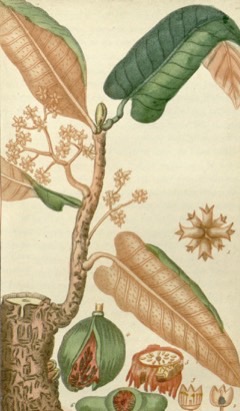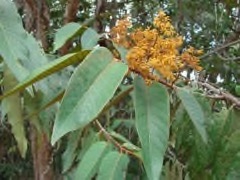 |
|
edibleplants.org |
 |
| Wikimedia.org - João Medeiros |
Translate this page:
Summary
Physical Characteristics

 Virola sebifera is a deciduous Tree growing to 25 m (82ft) by 20 m (65ft) at a medium rate.
Virola sebifera is a deciduous Tree growing to 25 m (82ft) by 20 m (65ft) at a medium rate.
See above for USDA hardiness. It is hardy to UK zone 10. The species is dioecious (individual flowers are either male or female, but only one sex is to be found on any one plant so both male and female plants must be grown if seed is required). . The plant is not self-fertile.
Suitable for: light (sandy), medium (loamy) and heavy (clay) soils and prefers well-drained soil. Suitable pH: mildly acid, neutral and basic (mildly alkaline) soils. It cannot grow in the shade. It prefers moist soil.
UK Hardiness Map
US Hardiness Map
Synonyms
Myristica cordifolia Mart. ex A.DC. Myristica fulva King Myristica mocoa A.DC. Myristica panamensis Hemsl. Myristica sebifera (Aubl.) Sw. Myristica virola Raeusch. Palala mocoa (A.DC.) Kuntze Palala panamensis (Hemsl.) Kuntze Virola boliviensis Warb. Virola mocoa (A.DC.) Warb. Virola mycetis Pulle Virola panamensis (Hemsl.) Warb. Virola peruviana tomentosa Warb. Virola venezuelensis Warb. Virola warburgii Pittier
Plant Habitats
Edible Uses
References More on Edible Uses
Medicinal Uses
Plants For A Future can not take any responsibility for any adverse effects from the use of plants. Always seek advice from a professional before using a plant medicinally.
The sap is used for treating ulcers and skin eruptions[348 ] The bark is astringent, emetic and stimulant[348 ].An infusion is used in the treatment of dyspepsia, intestinal colic, erysipelas and inflammations[739 ]. The bark is boiled with water and used to induce vomiting[348 ]. The macerated bark is soaked in water and drunk as an anti-diarrhoeal[348 ]. Juice from the bark is applied externally as an analgesic for cracked heels[348 ]. An infusion of the bark is used as a wash for cleaning contusions and ulcers[739 ]. A decoction of the bitter red sap from the bark is gargled or drunk to treat thrush and sores of the mouth. The sap becomes resinous on exposure to air and is then used to relieve the pain of toothache and to cauterize aphthae[348 ]. An exudate from the bark is worked into preparations with psychotropic properties by the native peoples of S. America[739 ].
References More on Medicinal Uses
The Bookshop: Edible Plant Books
Our Latest books on Perennial Plants For Food Forests and Permaculture Gardens in paperback or digital formats.

Edible Tropical Plants
Food Forest Plants for Hotter Conditions: 250+ Plants For Tropical Food Forests & Permaculture Gardens.
More

Edible Temperate Plants
Plants for Your Food Forest: 500 Plants for Temperate Food Forests & Permaculture Gardens.
More

More Books
PFAF have eight books available in paperback and digital formats. Browse the shop for more information.
Shop Now
Other Uses
The seed yields an oil formerly used as illuminating oil[348 ]. The oil is used for making candles and soap[378 ]. The seeds burn readily with a clear light. Native people stick them on a thin piece of hard wood and use them as torches when they have to go out in the dark[551 ]. Cut or damaged trees exude a blood-red, watery latex that is similar to the kino of commerce[378 ]. The heartwood is a uniform light reddish, greyish or brown; merging gradually into the pale golden to pale rose-brown sapwood[341 ]. The wood is straight-grained; medium-textured; with a medium to high lustre; odour and taste indistinct. It is moderately heavy; of low durability; very susceptible to termite and pinhole borer attack[341 , 419 ]. It works easily with ordinary tools and finishes well; nails and screws easily without splitting; it can be stained, varnished and polished with good results; turns satisfactorily; glues readily[341 ]. It is used for construction, internal finishing in buildings, toys, light boxes etc, and is suitable for making toothpicks[341 , 419 ].
Special Uses
Carbon Farming
References More on Other Uses
Cultivation details
Industrial Crop: Oil Management: Standard Regional Crop
Grows best in a sunny position[419 ]. Newly planted young trees are fairly slow to grow away, rarely surpassing 2 metres in height in the second year[419 ]. A dioecious species, both male and female forms need to be grown if seed is required[556 ].
Carbon Farming
-
Industrial Crop: Oil
Materials, chemicals and energy include bioplastics, biomass, glycerin, soaps, lubricants, paints, biodiesel. Oilseed crop types.
-
Management: Standard
Plants grow to their standard height. Harvest fruit, seeds, or other products. Non-Destructive management systems.
-
Regional Crop
These crops have been domesticated and cultivated regionally but have not been adopted elsewhere and are typically not traded globally, Examples in this broad category include perennial cottons and many nuts and staple fruits.
References Carbon Farming Information and Carbon Sequestration Information
Temperature Converter
Type a value in the Celsius field to convert the value to Fahrenheit:
Fahrenheit:
The PFAF Bookshop
Plants For A Future have a number of books available in paperback and digital form. Book titles include Edible Plants, Edible Perennials, Edible Trees,Edible Shrubs, Woodland Gardening, and Temperate Food Forest Plants. Our new book is Food Forest Plants For Hotter Conditions (Tropical and Sub-Tropical).
Shop Now
Plant Propagation
Seed - it has a limited viability and should be sown as soon as it is ripe. Sow in individual containers in a lightly shaded position. Germination rates are generally less than 30%, the seed sprouting within 30 - 50 days[419 ]. The seedlings grow away quite slowly[419 ].
Other Names
If available other names are mentioned here
Moulomba (Guyana); Sangre; Cumala Blanca (Peru); Camaticaro (Venezuela); Palo De Sangre; Colorado; Ucuuba (Brazil); Sebo (Colombia); Nuanamo (Colombia); Birma; Shempo (Ecuador); Cumala Colorada (Peru); Cumala (Peru); Pintri (Surinam); Cajuea (Trinidad & Tobago); Otivo (Venezuela); Virola (Venezuela); Cuajo (Venezuela); Sangrino (Venezuela); Chaliviande (Ecuador); Dalli (Guyana); Banak; Bicuiba Branca (Brazil); Tapsava; Virola (Brazil); Ucuhuba (Brazil); Yayamadou (Guyana); Baboen (Surinam); Chalviande (Ecuador); Tzimbo (Ecuador); Gabón (Bolivia); Sangrino (Venezuela); Cuajo (Venezuela); Virola (Venezuela); Cumala (Peru); Banak; Veuhuba; Venhuba; Babun; Sangre De Toro (Colombia); Bagabani; Sangre; Camaticaro; Baboen (Surinam); Dalli (Guyana). Man-dalli, Egron-baboen, Virola Nut. Red Ucuba. Pintri,
Native Range
SOUTHERN AMERICA: Costa Rica, Honduras, Nicaragua, Panama, French Guiana, Guyana, Suriname, Venezuela, Brazil (Acre, Amapá, Amazonas, Distrito Federal, Goiás, Maranhão, Mato Grosso, Minas Gerais, Pará, Rio de Janeiro, Rondônia, Roraima, São Paulo, Tocantins), Bolivia (El Beni, Pando), Colombia, Ecuador (Carchi, El Oro, Esmeraldas, Los Ríos, Morona Santiago, Napo, Pastaza, Pichincha, Sucumbíos, Zamora Chinchipe), Peru (Amazonas, Huánuco, Loreto, Madre de Dios, Pasco, San Martín)
Weed Potential
Right plant wrong place. We are currently updating this section.
Please note that a plant may be invasive in one area but may not in your area so it's worth checking.
None Known
Conservation Status
IUCN Red List of Threatened Plants Status : This taxon has not yet been assessed

Growth: S = slow M = medium F = fast. Soil: L = light (sandy) M = medium H = heavy (clay). pH: A = acid N = neutral B = basic (alkaline). Shade: F = full shade S = semi-shade N = no shade. Moisture: D = dry M = Moist We = wet Wa = water.
Now available:
Food Forest Plants for Mediterranean Conditions
350+ Perennial Plants For Mediterranean and Drier Food Forests and Permaculture Gardens.
[Paperback and eBook]
This is the third in Plants For A Future's series of plant guides for food forests tailored to
specific climate zones. Following volumes on temperate and tropical ecosystems, this book focuses
on species suited to Mediterranean conditions—regions with hot, dry summers and cool, wet winters,
often facing the added challenge of climate change.
Read More
Expert comment
Author
Aubl.
Botanical References
Links / References
For a list of references used on this page please go here
A special thanks to Ken Fern for some of the information used on this page.
Readers comment
| Add a comment |
|
If you have important information about this plant that may help other users please add a comment or link below. Only comments or links that are felt to be directly relevant to a plant will be included. If you think a comment/link or information contained on this page is inaccurate or misleading we would welcome your feedback at [email protected]. If you have questions about a plant please use the Forum on this website as we do not have the resources to answer questions ourselves.
* Please note: the comments by website users are not necessarily those held by PFAF and may give misleading or inaccurate information.
To leave a comment please Register or login here All comments need to be approved so will not appear immediately.
|
Subject : Virola sebifera
|
|
|
|